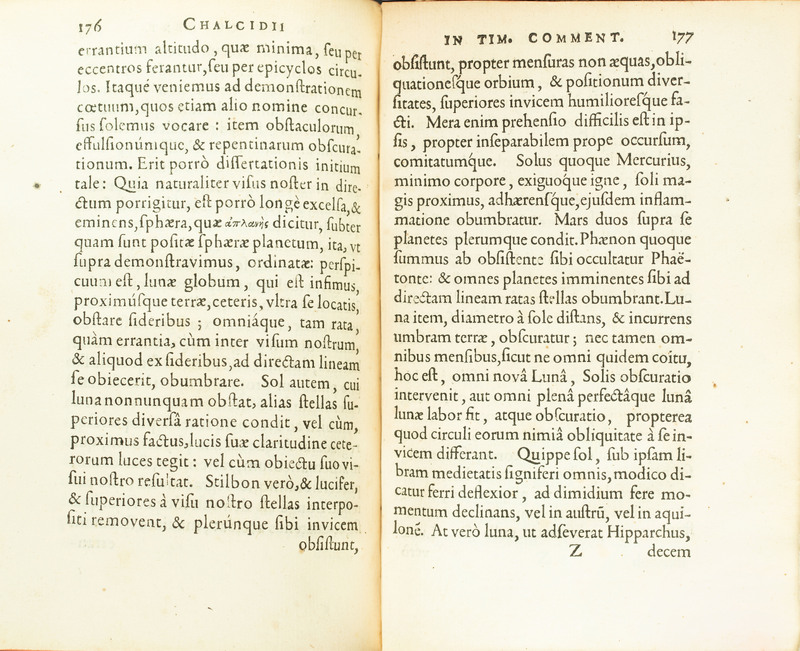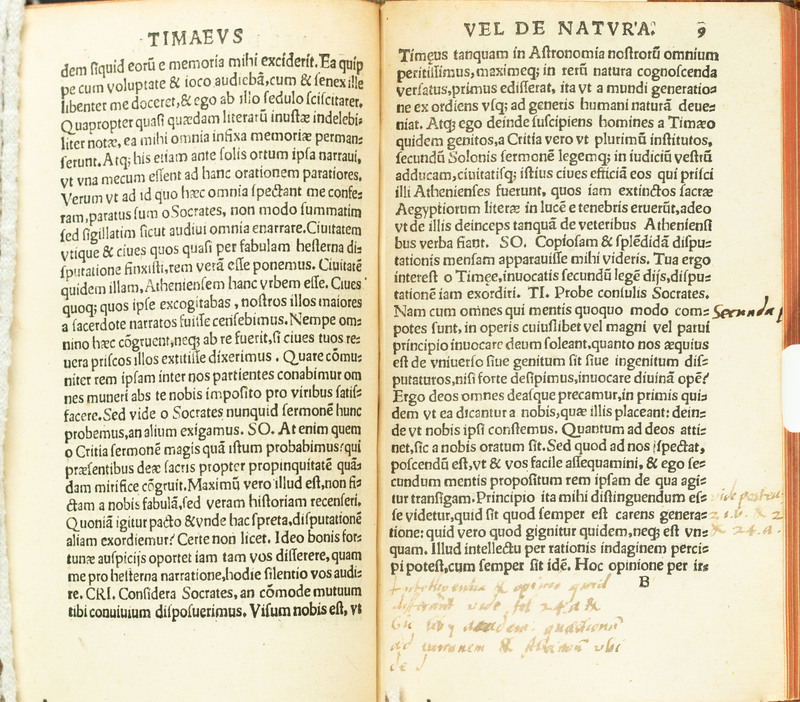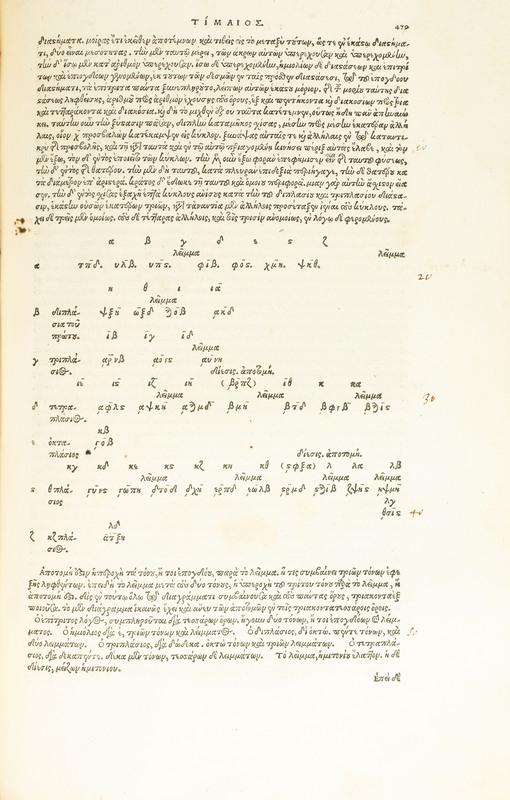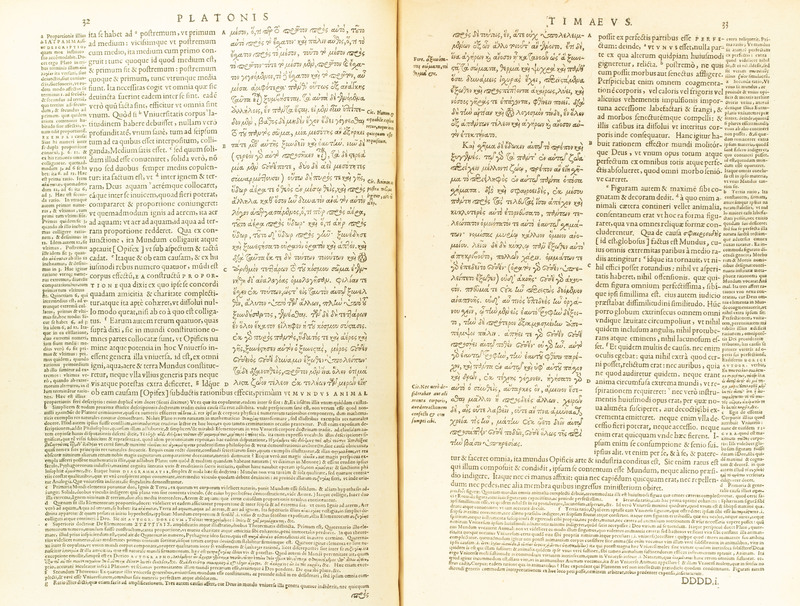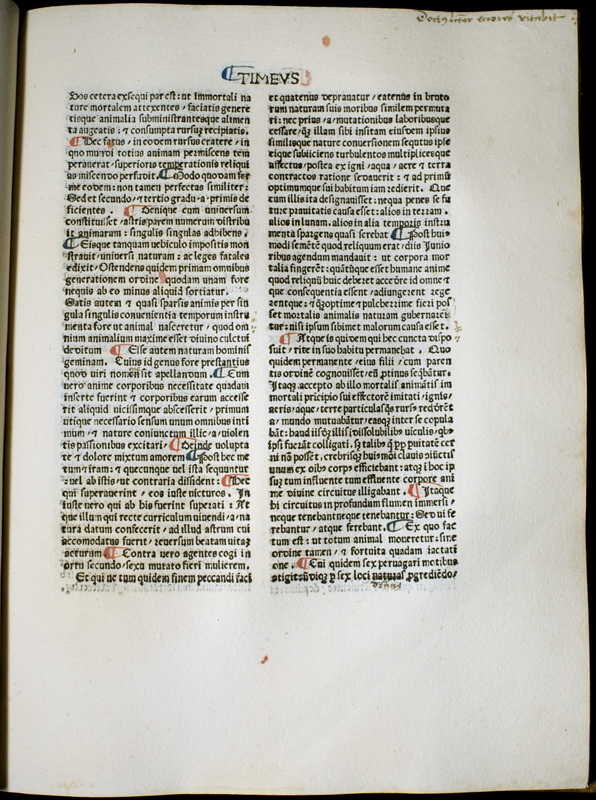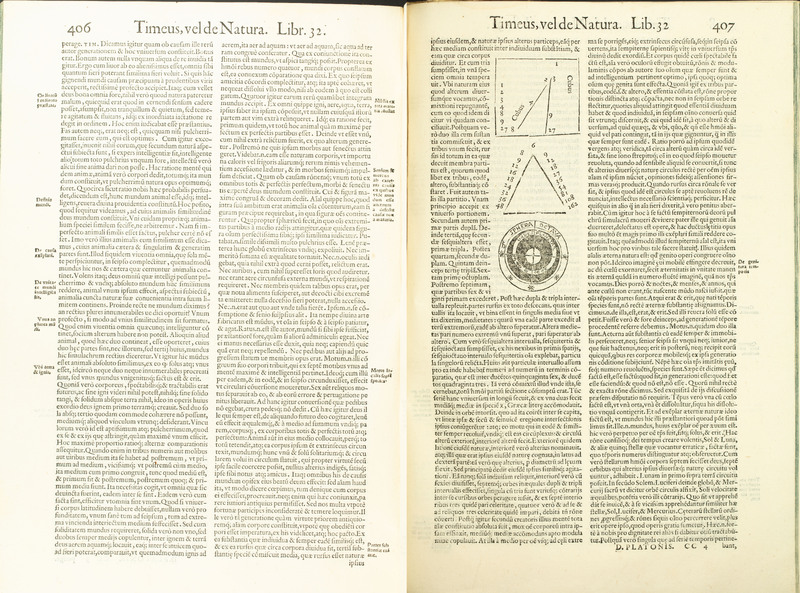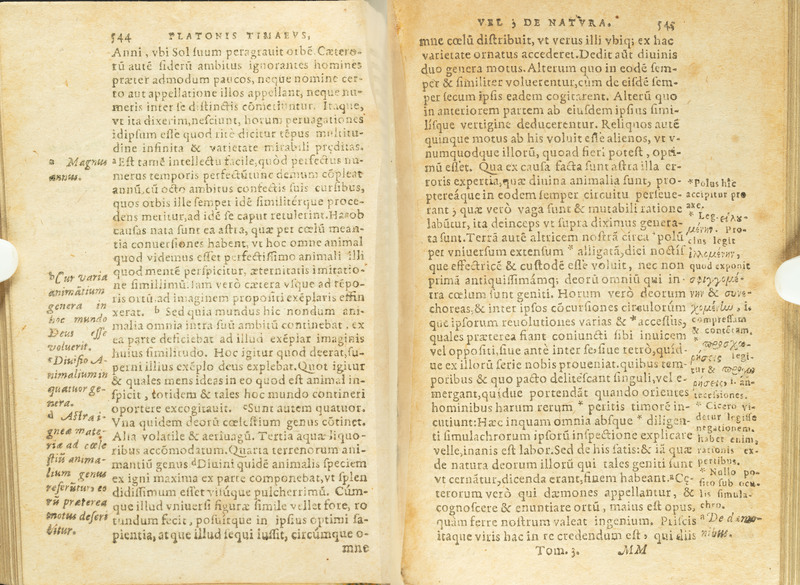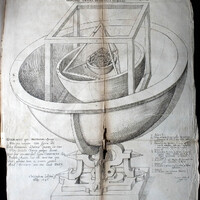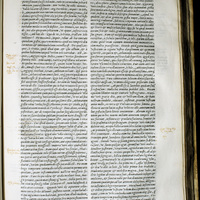Exhibit Contents
Part 1
Until Henricus Aristippus’ translation of the Meno and the Phaedo in the 12th century, the Timaeus was the only text of Plato available in the Middle Ages in the Latin West. The picture of Plato dominant during this time was accordingly quite different to the one in antiquity or the one we have: Plato would be consulted especially for information about the natural world and questions of natural philosophy, since he was seen mostly as a scientific and technical author1. One important reason for the dominance of the Timaeus was that early translations and commentaries preserved knowledge of the text into the Latin Middle Ages. The first commentary seems to have been already written sometime between the second half of the fourth and the beginning of the third century BC by Crantor, a member of the Old Academy2. The first Latin translation was provided by Cicero in the first century BC; Kepler, at the turn from the 16th to the 17th century, quoted from this translation. However, Cicero translated only a part of the dialogue (Timaeus 27d-47b), so he omitted the beginning and the whole second half. The selection he did translate was probably meant for inclusion into his own unfinished dialogue on cosmology that was to have shown his mastery of what was regarded as one of the most difficult philosophical texts in Greek in his Latin translation3.
Roughly two hundred and fifty years after Cicero, Galen paraphrased and summarized parts of the Timaeus, now with a specific interest in the later parts (untranslated by Cicero) dealing with the origins of diseases4. Galen’s paraphrases turned out to be the most important source for the reception of the Timaeus in the Arab world, where it was considered, alongside the Republic and the Laws, the most important text by Plato5. A commentary from the same century (second century AD) was written, surprisingly, by a Peripatetic, Adrastus, and is partly preserved in Theon of Smyrna6.
But arguably the most influential translation for the Latin West is the translation in the 4th century AD by Calcidius; it was “the ‘pass’ for Plato’s work to travel on to the Middle Ages in the West”, especially between the 9th and the 12th century7. Calcidius’ commentary, which commonly accompanied the translation, was heavily read, in certain periods even more so than the translation itself8.
In the following century Proclus wrote his commentary on the Timaeus, the first printed edition of his commentary!) which is only partly preserved. But since it was not translated into Latin before William of Moerbeke in the 13th century9, it was much less influential during the Middle Ages in the Latin West than Calcidius’ commentary. However, it was taken up again and frequently cited by Marsilio Ficino10 as the notes referring to Proclus’ commentary in the 1536 Ficino edition and the 1592 Ficino edition illustrate. So in spite of the substantial influence of the Timaeus, it was only with Ficino in the 15th century that the Latin West got the first complete translation of the work, since Cicero and Calcidius11 had both omitted parts of it. Moreover, Ficino wrote not one but two commentaries on the Timaeus, the first of which, however, is not extant. The second commentary was first published in Ficino's 1484 Platonis Opera Omnia translation; and its final edition was published in his 1496 Commentaria in Platonem12.
While Ficino’s commentary seems to have been inspired by Neoplatonism, e.g. by Proclus’ comments, Ioannes Serranus’ translation from 1578 tried to dissociate the Platonic text from its Neoplatonic interpretation prevalent up to that point. His Latin translation was printed by Henricus Stephanus alongside an edition of the Greek text of the Timaeus. It is this very edition that determined the pagination of the Platonic text still in use today. Soon the Timaeus was also published as a handy “travel book” and translated into vernacular languages.
Works Included
This book is the fourth volume in an edition of Cicero’s works published at Venice by Luca Antonius Junta between 1534 and 1537. This particular volume was printed in 1536 and contains some of Cicero’s philosophic texts. The pages displayed show the beginning of his partial translation of Plato’s Timaeus. The portion shown includes the preface, in which Cicero links Platonic doctrines with Nigidius Figulus (98-45 B.C.E) and Roman Pythagorianism; the translation follows, beginning with Timaeus’ opening questions and explanation thereof: “What is that which always is and has no becoming, and what is that which becomes but never is?” The translation ends at Timaeus 47b, with the discussion regarding the purpose of eyesight and its crucial role in philosophy. Cicero’s translation was read by a number of well-known late antique scholars and had great influence on subsequent translations of the Timaeus.
This volume contains a seventeenth-century edition of the Latin translation and commentary on the Timaeus originally produced by Calcidius in the fourth century. Calcidius’ translation, which ends at Timaeus 53c, is more complete than the one produced by Cicero. The medieval reception of Plato relied heavily upon Calcidius’ translation and commentary, which employed material from Middle and Neoplatonic sources to interpret the Timaeus. Calcidius’ work was studied widely throughout the Middle Ages and kindled a long tradition of glosses on the Timaeus. Critics note that Calcidean concepts soon became intermingled with Platonic doctrines. The displayed copy of Calcidius’ text was edited by the Dutch scholar Johannes Meursius (1579-1639), who provided additional notes in Greek and Latin on the translation. He also compiled the accompanying index of Platonic words and topics. The volume was printed in Leiden by Justus à Colster in 1617. The pages shown are from Calcidius’ commentary on the Timaeus, in particular from the section treating the motions of the stars.
This volume contains Marsilio Ficino’s Latin translation of the Timaeus, edited by Francisco Zampino. The text was printed in Paris by Prigent Calvarin in 1536 (a reprint of the original 1527 edition) and later bound together with four other texts published between 1532 and 1557 by various printers. These texts include the following works: Alcinous’ Philosophi ad Platonis Dogmata Introductio and Philosophi Platonici de Doctrina Platonis Liber, Speusippus’ Platonis Discipuli Liber de Platonis Definitionibus, Xenocrates’ Philosophi Platonici Liber de Morte, Marsilio Ficino’s translation of Plato’s Phaedo, Demetrius Phalereus’ De Elocutione Liber, and the Opuscula of Dionysius of Halicarnassus. In order to bind the Timaeus with these other texts, the pages had to be cut down to a uniform size. This process caused the truncation of certain marginal notes written prior to the rebinding. These notes reference other commentators on the Timaeus, including Cicero, Proclus, and Calcidius. The pages displayed translate a passage from the beginning of the Timaeus in which Critias concludes Solon’s story and Timaeus begins his cosmological speech.
This volume contains the second Greek edition of the Platonic corpus, edited by Johannes Oporinus and Simon Grynaeus; the text is based upon the Aldine edition of 1513. The book was printed at Basel by Joannes Valderum in March 1534. In addition to the text of Platonic works, the edition contains commentaries by Proclus on the Timaeus and the Republic. Notes in Latin, Greek, and French have been written throughout the volume. These notes often comment upon different readings of the text, citing sources including Cicero, Calcidius, and Proclus; printing errors are also pointed out and corrected*. The pages displayed are from the section of the Timaeus in which the composition of the world’s body and soul is described. The chart on the right page relates to Proclus’ commentary on the Timaeus 35b-36b, where Plato states that the Demiurge created harmonious divisions of the world soul. Conforming to Pythagorean numerology, Plato’s conception of harmony, music, and geometry depended upon integer multiples and divisions:
2 x 1 = 2 2 x 2 = 4 2 x 4 = 8
3 x 1 = 3 3 x 3 = 9 3 x 9 = 27
These integer relationships form musical intervals.
2:1 = octave
3:1 = double octave
3:2 = fifth
Ancient Greek studies in acoustics produced mathematical arrangements of proportions in order to establish their scale. The chart in this edition uses an alphanumeric system (α=1, β=2, κ=20, ρ=100, etc.), as seen below:
Thus, the proportions represented in the second horizontal line are:
432:384 = 9:8 (wholetone)
486:432 = 9:8 (wholetone)
512:486 = 256:243 (leimma, i.e. halftone)
576:512 = 9:8 (wholetone)
648:576 = 9:8 (wholetone)
729:648 = 9:8 (wholetone)
These intervals form a musical scale. The subsequent lines in the chart give similar proportions in greater multiples.
We credit Professor Jon Solomon for the translation of the chart for no. 4, and for his help in writing this description.
This edition of the Timaeus contains the translation and notes of Jean de Serres (1540-1598), a Calvinist Huguenot who sought to extirpate Neoplatonic elements from translation and commentary on Platonic works. Serres’ aim was to perceive the doctrine of Plato through study of the original texts. His work was published in 1578 by fellow Huguenot Henri II Estienne (1528/1531-1598) and dedicated to Queen Elizabeth I. The famous reference system known as “Stephanus pagination” was based upon the numbering in this edition of the Platonic corpus. The Latin translation of each Platonic dialogue is set alongside an edition of the original Greek text. Marginal notes give references to other philosophical texts, such as Cicero. Notably, Serres’ explanations do not refer to popular Neoplatonic commentaries such as those by Calcidius and Proclus. The pages displayed correspond to the section of the Timaeus in which the composition and other characteristics of the world’s body are described.
This volume, printed in 1484 in Florence, contains the Platonis Opera Omnia of Marsilio Ficino (1433-1499) – the leading Plato scholar of the 15th century, head of the Platonic Academy in Florence, and first translator of Plato’s complete extant works into Latin. The translation of the Timaeus is prefaced by Ficino’s commentary on the work, titled Compendium in Timeum. It is possible that Ficino chose to publish in 1484 because of its astrological significance – the conjunction of Saturn and Jupiter (which he mentions in the argument to one of Plato’s Letters) was supposed to herald great changes in Christianity. The pages displayed translate the portion of the Timaeus in which the lesser gods are created and proceed to create human beings. These pages also bear traces of a later reader. S/he has marked the second column of the left page with marginal lines and an abbreviation meaning Nota bene (“mark well”). The right page includes several corrections written in the text. At the top of the right page, the emender has written a testimony to conscientious reading:
Doctus lector errores vitabit (“The learned reader will shun errors”).
Jacobus Tapia Aldana edited and corrected this edition of Marsilio Ficino’s Platonis Opera Omnia. The volume, which includes a detailed index, was printed at Venice by Hieronymus Scotus in 1571. The pages displayed correspond to the Timaeus passage29d-38e. Subjects covered in this section include the reason for the creation of the world, the composition of the world’s body and soul, the union of the world’s soul with its body, and the creation of time. Brief topical captions have been written in the margins of the text.
This diminutive codex contains a portion of Marsilio Ficino’s Platonis Opera Omnia. Simon Grynaeus (1493-1541), an anonymous Lyonnaise editor, and Estienne Tremblay (1556-1597) have all revised the text appearing in this edition. Jacobus Stoer printed this three-volume edition of Ficino’s text at Geneva in 1592. The volumes are small enough to be used as portable reading material. Marginal notes of two sorts are found in this translation. Notes in normal type give different readings or translations of the text along with the scholar from whom these readings stem; scholars cited include Cicero and Proclus. Notes in italics are topical headings or interpretations of the text. The pages displayed translate the Timaeus passage in which the periods of heavenly bodies and the completion of the Perfect Year are described, as well as the creation of stars and gods.
This translation and commentary on the Timaeus by the humanist Loys le Roy (1510?-1577) contains the first known translation of the dialogue from Greek into French. The volume belongs to the second printing of Le Roy’s translation, produced in Paris by Abel l’Angelier in 1582 (click here to see the title page). It also contains a French translation of Plutarch’s treatise on the creation of the soul., an event which Plato describes in the Timaeus. The text is divided into four parts, although the precise point of division between the third and fourth parts is uncertain. Marginal numbers, such as the ‘4’ printed on the left page displayed, direct the reader to endnotes printed after the section. Simple diagrams are printed occasionally throughout the work. The Timaeus passage shown treats bodily diseases, particularly how they arise and are propogated. The Greek note in the margin is a direct quotation from Timaeus 82e: ὅταν γὰρ τηκομένη σάρξ, meaning “whenever flesh decomposes.”

